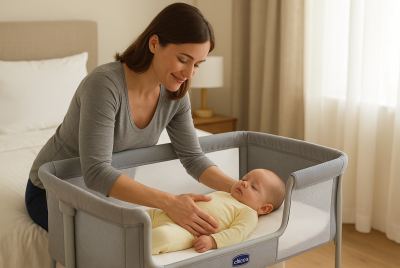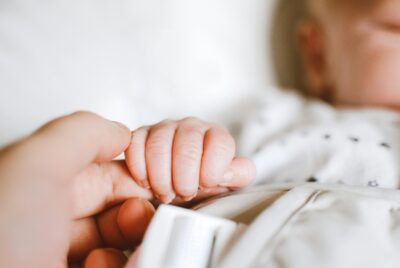Weighted Baby Sleep Sack: Everything You Need to Know
We may earn a commission for purchases made using our links. Please see our disclosure to learn more.
Let’s be honest—finding a reliable sleep solution for your baby might feel like a never-ending maze. When all you want is a few hours of uninterrupted sleep and some peace of mind, anything that can help seems like the Holy Grail. That’s where the weighted baby sleep sack comes in; it’s a cute, cuddly, wearable blanket that makes your baby feel safe and increases your chances of getting more sleep. However, what is a weighted baby sleep sack precisely, and why is it so popular? Let’s dissect it!
What Is a Weighted Baby Sleep Sack?
Think of a weighted baby sleep sack like a super-comforting blanket that your baby wears. It’s specifically designed with evenly distributed weight around the torso area. It’s not heavy—just enough weight to mimic the gentle pressure of a comforting hug. It’s like the perfect blend of a regular sleep sack (you know, the kind that keeps your baby snug) and the magical calm of an adult weighted blanket. And, spoiler alert: it works wonders.
Why Use a Weighted Sleep Sack for Your Baby?
So, why is everyone buzzing about weighted sleep sacks? Simple—if you’ve ever tried to put a baby to sleep (and let’s be honest, we’ve all done the endless rocking, pacing, and lullaby singing), you know they just want to feel cradled. Babies love the sensation of being held or swaddled, and a weighted sleep sack gives them that hug-like pressure. It’s almost like the sleep sack whispers, “You’re safe, it’s okay.” The result? Less fussing, longer naps, and (if you’re lucky) more uninterrupted sleep for both of you. Sounds like a dream, right?
Benefits of Using a Weighted Sleep Sack
Alright, let’s dive into why this nifty little sleep aid is getting all the hype.
- Longer Sleep Duration
Babies wake up for all sorts of reasons—their startle reflex, feeling unsafe, or just because they can. A weighted sleep sack can help cut down on these wake-up calls by making your baby feel more secure, leading to longer, uninterrupted sleep stretches (aka bliss). - Soothing and Calming
That slight weight in the sleep sack? It’s doing something magical called deep-touch pressure, which calms babies by stimulating their parasympathetic nervous system (fancy, huh?). Basically, it helps them relax and chill out. Cue the “Ahhh” moment for everyone. - Easy Transition from Swaddling
If your baby is done with swaddling but still craves that snug feeling, a weighted sleep sack is like the perfect next step. It gives them the comfort without restricting their movements. It’s a win for both baby and parent. - Promotes a Safe Sleep Environment
Loose blankets? Not ideal in a crib. But a sleep sack? It keeps your baby warm and snug without the risk of blankets getting tangled up or (heaven forbid) covering their face. Safety first!
How Does It Work?
The magic behind a weighted sleep sack lies in its carefully placed weight. Unlike weighted blankets for adults, which can be a bit on the heavier side, baby sleep sacks are designed with just the right amount of weight, spread across the chest or tummy. It’s like the baby equivalent of a comforting hug that tells them, “Relax, you’re safe.” This feeling of security helps babies fall asleep faster and (fingers crossed) stay asleep longer.
Is It Safe to Use a Weighted Sleep Sack?
Safety is always a big deal, especially when it comes to your baby. The good news? When used correctly, weighted sleep sacks are totally safe. They’re designed to meet strict safety standards, meaning the weight is light enough to be comforting without restricting your baby’s movement or breathing. Just make sure you’re following the manufacturer’s guidelines, ensuring the sleep sack fits your baby properly, and avoiding any extras in the crib (pillows, blankets, etc.). Safety first, always!
What to Look for When Buying a Weighted Sleep Sack
So, you’re sold on the idea, but now you need to pick the right weighted sleep sack. Here’s what to keep in mind:
- Material
Opt for sleep sacks made of soft, breathable fabrics like cotton or bamboo. You don’t want your baby getting too hot during sleep (because who sleeps well when they’re sweating?). - Weight Distribution
Check that the weight is spread evenly across the chest and tummy area. You want just enough weight to be comforting, not too much on the legs or shoulders. - Size and Fit
A good fit is key! The sleep sack should be snug but not too tight. Most come in sizes tailored to specific age groups, so make sure you’re choosing the right one for your baby’s age and size. - Washability
Babies = messes. Make sure the sleep sack is machine washable because, trust me, you’ll need to toss it in the wash more often than you think. - Zipper Placement
Look for a zipper that runs from top to bottom. It’s a lifesaver for those middle-of-the-night diaper changes when you don’t want to fully wake the baby.
When to Introduce a Weighted Sleep Sack
So, when’s the right time to whip out the weighted sleep sack? Most experts suggest waiting until your baby is 3 to 6 months old and has transitioned out of swaddling. Once your baby starts rolling over, a weighted sleep sack is great because it gives them the freedom to move their arms and legs while still offering that comforting weight.
Do Weighted Sleep Sacks Help With Sleep Regression?
Ah, sleep regression—the bane of every parent’s existence. It tends to hit right when you think you’ve finally figured out your baby’s sleep routine (around 4 to 6 months, give or take). Enter the weighted sleep sack. Its gentle pressure can help your baby feel more secure during these sleep disruptions, making it easier for them to fall back into a peaceful slumber.
Alternatives to a Weighted Sleep Sack
Not sure if a weighted sleep sack is the right choice? Don’t worry, there are other options out there!
- Regular Sleep Sacks
They offer warmth and that secure feeling without the extra weight. - Swaddle Transition Blankets
Great for babies who still want a snug fit but are starting to outgrow traditional swaddling. - Swaddle Wraps
Perfect for younger babies in the early stages of sleep development.
How to Use a Weighted Sleep Sack Safely
Here are a few tips to ensure your baby’s safety while using a weighted sleep sack:
- Follow Weight Guidelines
Make sure the sleep sack is age-appropriate and that the weight falls within safe limits for your baby’s size. - Ensure Proper Fit
It should fit snugly around the chest but allow room for your baby’s legs to move freely. A sack that’s too large can pose a suffocation risk, so double-check the sizing. - Monitor Baby’s Temperature
Weighted sleep sacks provide warmth, but you don’t want your baby to overheat. Always dress them appropriately and check their temperature during sleep.
Scientific Research on Swaddling and Its Effects
Did you know there’s actual science behind the benefits of weighted sleep sacks and swaddling? Here’s what the research says:
- Calming Effects of Swaddling
Studies show that swaddling significantly reduces crying time in babies, especially in stressful situations (like for babies with neonatal abstinence syndrome). Weighted sleep sacks mimic this calming sensation by offering gentle pressure that helps soothe fussy babies. - Improved Sleep Quality Through Swaddling
Swaddled babies tend to sleep more deeply, experience fewer startle reflexes, and are more likely to fall back asleep than non-swaddled babies. The secure, snug feeling from a weighted sleep sack provides similar benefits, making it a great option for improving sleep quality.
Related Products to Weighted Baby Sleep Sacks
If you’re looking to up your baby’s sleep game even more, here are a few products that pair well with a weighted sleep sack:
- Swaddle Blankets
A must-have for newborns who aren’t quite ready for a weighted sleep sack but still need that snug feeling. - White Noise Machines
Babies love white noise because it mimics the soothing whoosh of the womb. These machines can help block out household noises and create a calming sleep environment. - Blackout Curtains
Keeping the room dark helps babies maintain a consistent sleep schedule, even during daylight naps. - Pacifiers
For babies who find comfort in sucking, a pacifier can be a great companion to a weighted sleep sack. - Smart Baby Monitors
Want to keep an eye on your baby’s sleep patterns? Smart monitors can track their breathing and movement, giving you peace of mind while they sleep.
FAQs About Weighted Baby Sleep Sacks
- Are weighted sleep sacks safe for newborns?
Not recommended. Most weighted sleep sacks are designed for babies 3 months and older who are transitioning out of swaddling. - Can my baby roll over in a weighted sleep sack?
Yes, most are designed to allow safe movement, but always monitor your baby’s ability to roll over. - Will a weighted sleep sack help with my baby’s colic?
It might! While not a magic cure, the gentle pressure can help soothe a fussy baby, especially during colicky episodes. - How long can my baby use a weighted sleep sack?
Babies can use them until around 12 to 18 months, depending on the product’s size and your baby’s growth. - What should my baby wear under a weighted sleep sack?
Dress your baby according to the room temperature—a long-sleeve onesie for cooler nights or a short-sleeve one for warmer temps.
Conclusion: Is a Weighted Baby Sleep Sack Right for Your Family?
In the end, the weighted baby sleep sack could be just what you need to get your little one sleeping soundly. It combines comfort, safety, and a little extra coziness to make your baby feel secure, like they’re getting a constant hug. While it might not solve every sleep issue, it’s definitely worth trying if you want to give both your baby (and yourself) a chance at better sleep!




